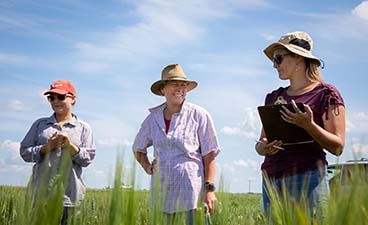
CFANS Adapts: Ruth Dill-Macky transforms plant pathology lab to online format
Universities around the world are moving classes online as COVID-19 continues to spread. One of the greatest feats when bringing a course online is how to also convert the lab to a digital environment. Department of Plant Pathology Professor Ruth Dill-Macky did just that. With the help of other faculty, staff, and graduate students the Introduction to plant pathology now lives and breaths on an online format.
How has putting your course online changed your teaching methods?
Only somewhat. The lecture portion of the class feels a bit different and if I had started online I would have changed some things (like made several short pre-recorded presentations available to students online rather than posting a recording of the full lecture). Given the changed circumstances we have all found ourselves in, I have been more lenient on deadlines. I have maintained all the deadlines but dropped any penalties for late work (letting the students who miss deadlines know that they can still hand the work in; for a few students this has been helpful)
What’s the most difficult aspect of taking a face to face lab and flipping it to an online format?
The biggest issue has just been finding the time to get all the materials into a format for online, and doing it in a timely fashion and getting the materials into Canvas in a logical order for the students to use. Over the past couple of weeks, we have developed a system. Todd Burnes prepped the lab materials, Becca Hall captured materials on video and took photos of all the static class materials and uploads those images to the share drive, Grant Czadzeck then converted those files formats to what we can use, Rae Page, Nick and I took those raw materials and made PowerPoint files that serve at the stations we have in the class. I then proofed everything—making edits as necessary—and got all the materials we need for the weekly lab uploaded into Canvas. All that happens Monday and Tuesday for the Wednesday lab classes. It takes lots of time but the end result seems to be working pretty well. I, along with one TA, meet with the students in our Zoom classroom as the students work through the lab materials we provide. Many of the questions posed by the students mirror those that have come up in those labs. While it is not quite the same experience for the students I feel they are meeting the class learning objectives. They miss using the microscopes, or so they say! Like all of us, the last few months have been tough and some students have found themselves challenged like never before. In some instances, this has meant that a few students are struggling to engage and complete the materials. Checking in with these students and encouraging them along seems to be working.
What was your method to adapt a face-to-face course to online?
Communication really has been the key. Making announcements and reminders and asking for feedback, finding out what is working, and letting students know that we are here to work with them to help them complete the course requirements. Keeping as much contact with the students as ever but provide the materials in a format that they can access online has been helpful. I am super grateful for the weeks we did spend together as a class. I got to know the students and I think that helped us all move to an online format more easily than had we not had the weeks we had together.
When courses resume in person do you think you will continue to pursue online formats for courses?
Moving some of the assessment online has some benefits. I generally give two mid-semester exams in class periods. The second one of these moved into an online format and these may stay online freeing up a couple of lectures so I could bring even more active learning into the classroom.
What is your highlight or a favorite moment you had while teaching online?
I was really pleased to know that my class is still engaging students. Each year I start Spring Semester with the goal of sparking a few students enough to get them thinking about other opportunities in plant pathology (e.g. UROPs, internships, or graduate school). I am so pleased that this appears to have happened this semester too. We have even had a student enjoy the lab classes enough that they attended both sessions some weeks just to be with us in the Zoom classroom. When students show up because they want to be there and not just to get a grade, it makes the effort we all put in feel pretty worthwhile. For whatever reason, each class of students is different, why I can’t say but every year a group of thirty students has a different dynamic. The class of spring 2020 has just been awesome. It has been a huge amount of working converting materials since we went online at Spring break, but the feedback has been overwhelmingly positive and for me, that has made it really rewarding.






